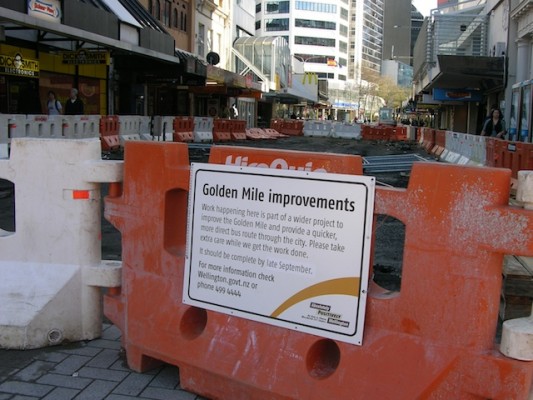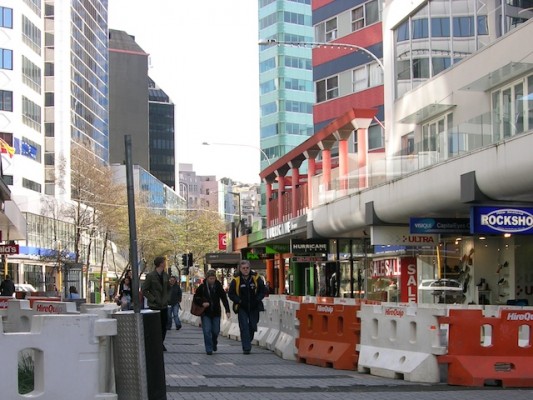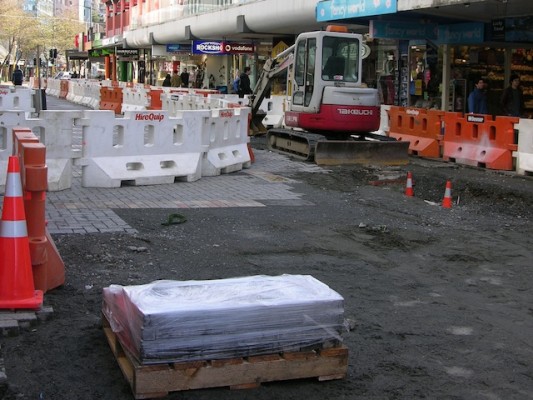Bad Manners
Wellington’s $11.1m Manners St bus project is taking shape but local businesses are complaining.
There’s a funny store in the local press here in Wellington in which staff complain the project has slowed to a crawl and people working in the street claimed to have seen workers having naps on the job, sleeping in trucks and others taking breaks of several hours.
That’s something the council didn’t dispute in the report but said it was becuase the workers had started work early.
The council said they had found “inconsistent conditions beneath the surface” that needed sorting out and had contributed to the project slowing.
The project is due for completion mid-September.
I have been photographing Auckland construction projects for more than 18 months now and must confess I have seen workers having a nap but with often 24-hour work going on and hard physical work in Auckland’s fierce summer sun, that’s understandable. Or maybe it’s their lunch breaks. I don’t see an issue.
One night, I did interrupt roading workers crammed into a truck having a joint!
New stormwater drains were laid across Manners Mall at various points before the new two-way bus-only roadway with wide paved footpaths on either side could be constructed.
The changes will enable buses to travel in both directions from the railway station to Courtenay Place through Lambton Quay, Willis Street and Manners Street, restoring the route trams and buses used before Manners Mall was created in the late 1970s.
Buses should be using the new route before Christmas.
The council insists Manners Street will continue to be a major pedestrian thoroughfare with wide paved footpaths on either side.
Work on the new shared space planned for lower Cuba Street starts early in the new year.
I have always loved the eccentric nature of Cuba St, left over from its hippie 70s era and hope it never changes.
Just had some great coffee at Olive too.

















9 Comments
amazing the things you come across in the course of preparing blog posts. Surely that sort of workplace activity is a matter between the workers and their employer. As long as the employer delivers to a high standard and on time who cares if they need the occasional nap.
LOL I think theres some cause for concern here, mainly that these workers are snoozing on company time, and that cost (along with lost time) is passed on (with a margin) to the rest of us. There’s also safety and quality issues where workers turn up or are at the job and are so tired they can’t help but try and take naps.
They snooze, we all lose! No wonder PT projects cost so much!
There seems to be a general perception that construction workers are slackers. I think what people don’t realise is that it is often difficult to keep workers fully occupied during a project, especially if unexpected things crop up. Things have to happen in a certain sequence and it depends on the right people and equipment being there at the right time.
For example you might hold off ordering a concrete truck until you are sure the site will be ready to receive the concrete. In this case you may have some workers idle for an hour or two waiting for it. If you order the truck too early you risk having to send the truck away which is likely to be very expensive compared with a few hours wages.
I would be very surprised if workers are simply not working for long periods of time (out of their breaks) for no good reason. It will be a private contractor carrying out the work, and I am sure their margins aren’t large at the moment.
“and that cost (along with lost time) is passed on (with a margin) to the rest of us.”
Sorry, but you seem to have very little idea of how the construction industry works. It’s a cut-throat business for the contractor, who does NOT get paid on hours worked (or hours not really worked). In 99% of the cases he’s tendered for a fixed price, and if he spends extra, that is HIS money out of his pocket, not the Council’s. He can only charge more if the job changes halfway through - i.e. if the plans are changed, or something materially new is found out about the project that he did NOT have to take on the risk for anyway (i.e. if he’s lucky, he might have an escape clause - often he does not).
Also, I fully agree with Matthew. Construction work scheduling is an art on its on, and what should the workers do if something elsewhere is delayed? Maybe they could get some early start on paving the top while waiting for the basecourse to be delivered? NOT.
Also, look at office workers, and how often THEY slack, with a lot less excuse too (myself not excluded). We just LOOK more busy and are less in the public eye while we are surfing the net and posting on blogs!
You’d be surprised Carl, but I think you’re a bit mixed up here. Depends on how things are organised but you’re probably confusing subcontractors with the main contractor who will retain them for a given job.
The main contractor generally adopts a cost plus margin approach or provides a fixed price or GMP with a wide enough scope to ensure a minimum margin with upside, so this is where much of the profits will go.
In any event, the subbies could price a lot better if they didn’t have factor paying staff to sit and sleep around - there’s always other work to do if you’re prepared - that’s where good planning from the subbie and good project management from the client or head contractor comes in. Not many subbies I know commit to fixed price unless they’re 100% sure, and most don’t sit around doing nothing and getting paid!
I remind you that taxpayers are paying for the $11M+ project. Probably upwards of $2.5 M in margins here all round. I think it’s important not to make excuses here…
Fair enough, if you know in fact that the arrangement allows for price flexibility. I primarily know of government contracts being fixed price, but admittedly that was overseas. Alliance models and similar seem to be more common here.
However, you said that the main contractor “provides a fixed price or GMP with a wide enough scope”.
So in that case, why should the taxpayer care about workers lounging on the job (either for lazieness or because they are waiting for something else to be done before they can continue)? The taxpayer / ratepayer is still getting the same price and the same result (assuming of course that despite the inefficiencies the contractor may have, the project is still delivered on time).
Anything’s possible, but typically with fixed price, the contractor usually gives himself enough scope to substitute where possible to meet the price (eg replace concrete with asphalt etc) and indeed, the smart ones will do all that and more - why do you think we need to legally require homes to be insulated and other building regulations?
If someone’s paying for workers to laze around or sleep, trust me, the end customer pays. No one else is absorbing the cost of idle workers, it’s just passed up the chain.
Maybe Manners might cost upwards of $300,000 less (all costs. beyond wages) if better planning meant no paid workers were getting paid to do squat.
“Maybe Manners might cost upwards of $300,000 less (all costs. beyond wages) if better planning meant no paid workers were getting paid to do squat.”
Maybe. Where do you get those numbers from, though? And that maybe is based on another couple of maybe’s. Such as the base assumption, i.e. that the workers at Manners Mall ARE in fact lazier or less occupied by their management than anywhere else - and not just getting more complaints because they work on a busy pedestrian mall on a change that has been controversial!
There’s been quite a lot of research around this kind of thing. $300,000+ is still less than 3% of the total cost, but is a lot of cash that could be spent much more effectively elsewhere - ie on projects where workers are not sleeping on the job!
Idle workers in construction has been a problem for years and google is your friend! Let’s not make excuses for them.
I agree - high visibility makes the shirking and paying people to do nothing very obvious, it is much easier to sleep on the job when the construction is fenced in or out of the public eye.